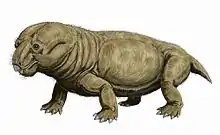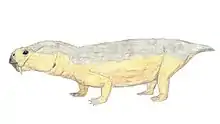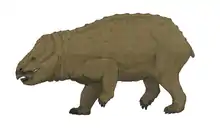Daptocephalus
Daptocephalus is an extinct genus of non-mammalian synapsid anomodont dicynodont, it which was found in Late Permian strata, in a biozone known precisely for the presence of fossils of this dicynodont, the Daptocephalus Zone, in the Karoo Basin in South Africa.[1][2] An additional species, D. huenei, is known from the Usili Formation in Tanzania and was formerly assigned to the genus Dicynodon before a study in 2019 recognised that the type specimen belonged to Daptocephalus.[3]
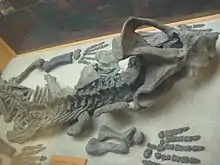
cf. D. leoniceps
| Daptocephalus | |
|---|---|
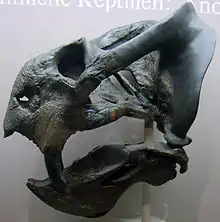 | |
| Daptocephalus leoniceps skull at the Museum für Naturkunde, Berlin | |
| Scientific classification | |
| Kingdom: | Animalia |
| Phylum: | Chordata |
| Clade: | Therapsida |
| Clade: | †Dicynodontia |
| Infraorder: | †Dicynodontoidea |
| Genus: | †Daptocephalus van Hoepen, 1934 |
| Type species | |
| †Daptocephalus leoniceps Owen, 1876 | |
| Species | |
| |
| Synonyms | |
|
List
| |
See also
References
- Viglietti, P. A., Smith, R. M., Angielczyk, K. D., Kammerer, C. F., Fröbisch, J., & Rubidge, B. S. (2016). The Daptocephalus Assemblage Zone (Lopingian), South Africa: a proposed biostratigraphy based on a new compilation of stratigraphic ranges. Journal of African Earth Sciences, 113, 153-164.
- R. F. Ewer. The anatomy of the anomodont Daptocephalus leoniceps (owen). Proceedings of the Zoological Society of London. doi 10.1111/j.1469-7998.1961.tb05881.x
- Christian F. Kammerer (2019). "Revision of the Tanzanian dicynodont Dicynodon huenei (Therapsida: Anomodontia) from the Permian Usili Formation". PeerJ. 7: e7420. doi:10.7717/peerj.7420. PMC 6708577. PMID 31497385.
This article is issued from Wikipedia. The text is licensed under Creative Commons - Attribution - Sharealike. Additional terms may apply for the media files.

